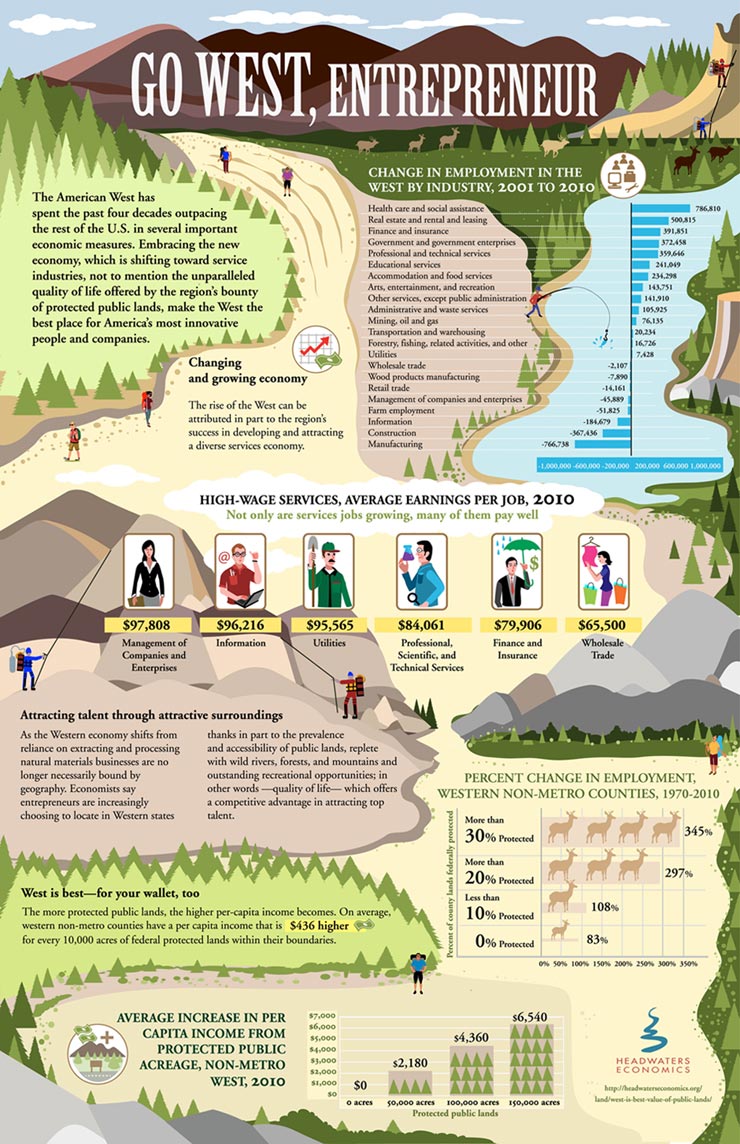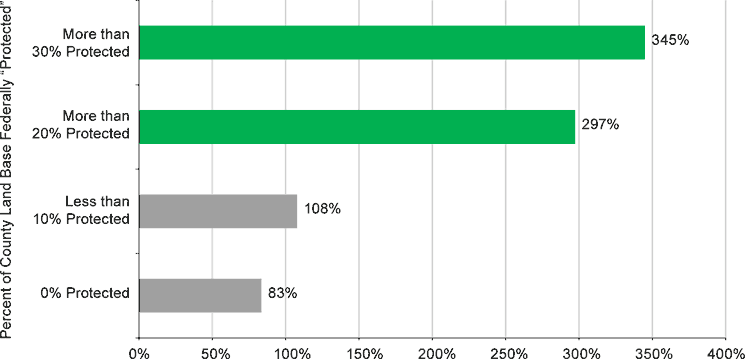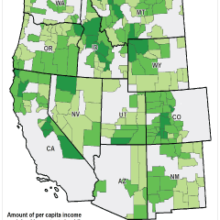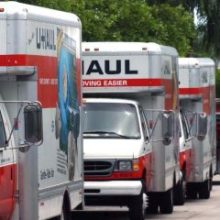State-Level Reports
New Economic Study, CEOs Say Public Lands Key to Competitive Advantage in the West
Western non-metro counties with more than 30 percent federal protected land increased jobs by 345 percent compared to 83 percent in counties with no protected land

“West Is Best” Infographic: Larger version (300K JPG) | Print-ready (6M PDF)
News Release
Bozeman, Mont. — A new economic study shows that the western United States is outperforming the rest of the country in job creation, personal income, and population growth, and that protected federal lands–such as national parks, monuments, and wilderness–are providing western states with a competitive economic advantage that has helped create more jobs and increase per capita income. The outdoor quality of life has also enabled rural and urban western communities to recruit entrepreneurs and retain talented employees, leading to a diverse and growing economy.
The study, “West is Best: How Public Lands in the West Create a Competitive Economic Advantage,” found that, from 1970 to 2010, western non-metro counties with more than 30 percent of their land base in federal protected status increased jobs by 345 percent. As the share of federal lands in protected status goes down, the rate of job growth declines as well. Western non-metro counties with no protected federal land increased jobs by 83 percent.
Protected public lands also provide personal income rewards. A statistical analysis done as part of the new report shows that, for non-metro counties in the West with protected federal lands, for every gain of 10,000 acres of protected public land, per-capita income in that county in 2010 on average was $436 higher.
“This study shows that entrepreneurs and America’s most talented workers are choosing to live in places where they can enjoy outdoor recreation and a quality of life,” said Ray Rasker, PhD, Executive Director of Headwaters Economics that completed the report. “By highlighting access to national parks, forests, and other public lands, western communities and companies have created new jobs faster than the rest of the U.S.”
According to the new Headwaters Economics report:
- Over the last four decades, western states are generally outperforming the rest of the country. The region’s employment, for example, grew by 152 percent compared to 78 percent for the rest of the country.
- This western job growth was almost entirely in services industries, such as health care, real estate, high-tech, and finance and insurance, which created 19.3 million net new jobs, many of them high-paying, from 1970 to 2010.
- Western non-metropolitan counties with more than 30 percent of the county’s land base federally protected–such as national parks, monuments, wilderness areas, and other similar designations–increased jobs by 345% over the last 40 years. By comparison, counties with no protected federal public land increased jobs by 83%.
- Per-capita income in western non-metropolitan counties with protected public lands is higher than in other similar counties. For every gain of 10,000 acres of protected public land, per-capita income in that county in 2010 was on average $436 higher. So a county with 50,000 acres of protected public lands was $2,180 higher; while one with 100,000 acres of protected public lands would have a $4,360 higher per capita income in 2010. For perspective, that same year the average per capita income for non-metro western counties was $34,870.
Percent Change in Employment, Non-Metro West, 1970 to 2010

Avg. Increase in Per Capita Income from Protected Public Lands, Non-Metro West, 2010

“Moving to the Pacific Northwest 15 years ago, the decision to start and grow our workforce management software company in Washington State, in the Seattle-area, was very deliberate. Being located in a region brimming with natural resources — national and state parks, forests, and other wilderness areas — just makes good economic sense, especially when our appeal to a well-educated, health-conscious workforce could not be greater,” said Bryan Lhuillier CEO of Shiftboard, Inc.
Santiago Becerra, Chairman & CEO of MeLLmo Inc., the creator of Roambi, said, “For our employees, taking time to get outdoors is reenergizing. It builds passion and commitment, and is critical to creativity and innovation this is where the best work happens. It’s also a competitive edge for us since not all companies work this way.”
Today’s economic report echoes a letter from one year ago in which more than 100 U.S. economists and related academics–including three Nobel winners–urged President Obama to “create jobs and support businesses by investing in our public lands infrastructure and establishing new protected areas such as parks, wilderness, and monuments.” The letter states federal protected public lands are essential to the West’s economic future, attracting innovative companies and workers, and contributing a vital component of the region’s competitive advantage.
The report also comes on the heels of a May 2012 poll conducted by Greenberg Quinlan Rosner Research of western small business owners in Arizona, Colorado, Nevada, and New Mexico. It found that these entrepreneurs see a direct link between protected public lands and business vitality. For example:
- 65 percent of owners believe designating new national parks and monuments would enhance local jobs and the economy while 52 agree it would help their state attract and retain new business and entrepreneurs.
Colorado-based Numerica Corporation develops advanced algorithms and software for tracking targets, fusing data and integrating networks. “Because of the nature of our work, Numerica could be located anywhere in the United States,” said Numerica President Jeff Poore. “But we choose to grow our business in Northern Colorado because of the quality of life it offers our employees.” Poore cited Colorado’s natural spaces and access to boundless outdoor recreation as key factors that positively influence top-talent recruitment and employee retention at Numerica, which is headquartered in Loveland.
“Great technology companies are built with great teams. Retaining and attracting top talent, across all roles, is the competitive advantage in today’s tech sector. We believe that talent wants challenging opportunities and a high quality of life. At TicketPrinting.com & Ticket River we have been able to retain and attract top talent, which has enabled us to build a company that now spans across the US, Canada, Australia, and the UK,” said Lance Trebesch, CEO of TicketPrinting.com. “Our team loves to work hard and they love to play hard, which means recreating across Montana’s public lands. It is our competitive advantage.”
Trebesch is one of dozens of CEOs that has signed a letter that will be sent to the White House and Congress seeking continued investment in and protections for public lands, in light of the ongoing fiscal cliff negotiations. “Protecting our national parks, forests, monuments, and public lands helps ensure that western communities, businesses, and entrepreneurs have a competitive advantage in the global marketplace,” the letter states.
The study was completed by Headwaters Economics, a non-profit economic research group based in Bozeman, Montana that specializes in community and economic development. The full report, state summaries, and other documents can be found at: https://headwaterseconomics.org/economic-development/trends-performance/west-is-best-value-of-public-lands/.


